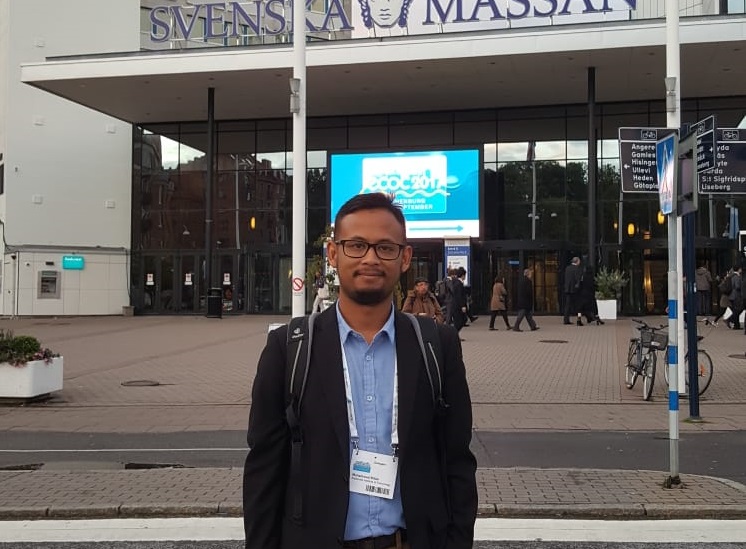ITS Alumnus Won 2018 Leibinger Innovation Prize

Muhammad Rodlin Billah, an ITS alumnus who is pursuing a Ph.D. degree at the Karlsruhe Institute of Technology (KIT) in Germany, won the prestigious 2018 Leibinger Innovation Prize.
Surabaya, ITS News – Muhammad Rodlin Billah, alumnus of the Physics Engineering Department of the Institut Teknologi Sepuluh Nopember (ITS) Surabaya, Indonesia, won the second best award for Leibinger Innovation Prize after take the innovation of Photonic Wire Bonding (PWB) techniques. The award is given to research groups from around the world who are considered to have contributed significantly to the laser field and its applications.
Photonic Wire Bonding (PWB) technique is a standard technique of fiber optic development in the industrial world to integrate photonic components and mass production at low cost through the polymerization of two photons (basic particles). As is known, the optical fiber is a transmission medium or a kind of plastic/glass cable used to transfer light signals from one place to another.
The man who is pursuing his doctoral studies at the Karlsruhe Institute of Technology (KIT) in Germany revealed that in 2020 there will be a capacity crunch phenomenon, namely the phenomenon of soaring data traffic beyond the growth of cable infrastructure or inadequacy to meet the demands of the world’s increasing information from year to year.
PWB is present as one of the photonics integration techniques that promise as an alternative data transport, especially in terms of scalability for mass production and production cost efficiency. This is because the two-photon polymerization integration techniques are simpler compared to other previous techniques. “Because of this, PWB is considered a big breakthrough,” said the father of one child.
If it viewed from the industry perspective, data storage service providers through the internet such as Google, Microsoft, and even Facebook will be able to increase their data storage capacity at a cheaper price.
While from the public eye, various internet services and applications such as streaming video from YouTube or video calls with WhatsApp will be accessed more quickly and cheaply so that they can realize the Internet of Things during the 4.0 Industrial Revolution.
The man who has lived in Germany since 2010 hopes that this innovation can show the importance of fiber optic communication systems for the world of communication in the present and the future. This should not only be done by building various fiber optic network data centers as has been attempted by the government but also followed by various universities to bringing up vocational study programs, masters, to doctoral in the field of optics and photonics, especially for the development of optical fiber.
The possibility of PWB Innovations Developed in Indonesia
The 2009-graduated of ITS revealed that PWB techniques have the potential to cost a lot cheaper than other photonic integration techniques. However, the supply of two-photon polymeric basic equipment and materials is still very expensive if the PWB is seen as a separate research field, especially in Indonesia. “For example, a femtosecond laser, one of the many important components for the TPP, has cost around Rp. 700 million,” he said.
This fee does not include the installation of special laboratory rooms and other equipment to coordinate the two-photon polymerization techniques. “In particular, the development of PWB techniques in Indonesia is still possible even though in turn they will face big challenges from this perspective,” he concluded. (rio/gol)
Related News
-
Faithful in Times of Joy and Sorrow, Married Couple Graduate with Doctorates Together at ITS
ITS Campus, ITS News — As though guided by one heart and one soul, Dr Hanugra Aulia Sidharta ST
November 12, 2018 14:11 -
ITS Wins 2024 Project Implementation Award for Commitment to Gender Implementation
ITS Campus, ITS News —Not only technology-oriented, Institut Teknologi Sepuluh Nopember (ITS) also show its commitment to support gender
November 12, 2018 14:11 -
ITS Professor Researched the Role of Human Integration in Sustainable Architecture
ITS Campus, ITS News –The developing era has an impact on many aspects of life, including in the field
November 12, 2018 14:11 -
ITS Sends Off Group for Joint Homecoming to 64 Destination Areas
ITS Campus, ITS News — Approaching Eid al-Fitr, the Sepuluh Nopember Institute of Technology (ITS) is once again facilitating academics who want
November 12, 2018 14:11
